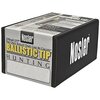WestKentucky
Member
I have long been a ballistic tip kinda hunter. Usually in .270 but have also use 30-30, .223, .243, 7-30, and the rimfire TNT 22mag and 17hmr. The ballistic tip always does its thing, massive fragmentation and huge wound cavity but not a ton of penetration. I understand the bullet type and what it’s supposed to do. Much like a super-speed hollowpoint (it is, just has a plastic tip in the void) it basically blows up on impact.
Tonight I shot a big doe. I’m not sure what happened here.
6.8spc hornady factory 110gr v-max ammo. Here’s the spec sheet from the hornady website.

22” heavy AR that’s coke can accurate to 600 yards with hand loads and the vmax performs identical out to about 300 before it starts opening up. At 100 yards or less this gun is just a laser beam death ray.
So… the shot. 8 does and a good enough buck came over the rise. I hadn’t verified that the gun was fully in battery and I missed my shot on the buck fiddling with the gun when it wouldn’t shoot. Out of battery and a slap on the forward assist actually worked. The deer all went into the woods but the does came back out a few minutes later, the buck never came back. Big doe was standing in the low spot with good backstop and close range. Perfect broadside and she was looking away. High shoulder shot found its mark and she just dropped in her tracks. Sack of taters hitting the ground kinda drop. But she kept kicking around and after a minute or two she seemed to be coming back to life right to the point where she was trying to stand up so I closed to 20 yards and put a round through the bottom of the rib cage angled up towards the base of her neck. Quite the shot on that one, it took out heart and 1 lung, and she was down for the count in a matter of seconds.
I’m totally ok with shot 2. It blew up but it did so how a ballistic tip does. It hit rib and there was shards of bone in heart, lungs, and likely everything else in the chest. The first shot has me stumped though. Wide open shot so no debris along the way. Placement was good. I made the shot I intended to make. The bullet seemed to just drill a hole straight through. I have never seen a ballistic tip do that.
What went wrong? From the way she just fell I’m assuming I got what I have heard referred to as spinal shock, but why didn’t the bullet do its thing?
Tonight I shot a big doe. I’m not sure what happened here.
6.8spc hornady factory 110gr v-max ammo. Here’s the spec sheet from the hornady website.

22” heavy AR that’s coke can accurate to 600 yards with hand loads and the vmax performs identical out to about 300 before it starts opening up. At 100 yards or less this gun is just a laser beam death ray.
So… the shot. 8 does and a good enough buck came over the rise. I hadn’t verified that the gun was fully in battery and I missed my shot on the buck fiddling with the gun when it wouldn’t shoot. Out of battery and a slap on the forward assist actually worked. The deer all went into the woods but the does came back out a few minutes later, the buck never came back. Big doe was standing in the low spot with good backstop and close range. Perfect broadside and she was looking away. High shoulder shot found its mark and she just dropped in her tracks. Sack of taters hitting the ground kinda drop. But she kept kicking around and after a minute or two she seemed to be coming back to life right to the point where she was trying to stand up so I closed to 20 yards and put a round through the bottom of the rib cage angled up towards the base of her neck. Quite the shot on that one, it took out heart and 1 lung, and she was down for the count in a matter of seconds.
I’m totally ok with shot 2. It blew up but it did so how a ballistic tip does. It hit rib and there was shards of bone in heart, lungs, and likely everything else in the chest. The first shot has me stumped though. Wide open shot so no debris along the way. Placement was good. I made the shot I intended to make. The bullet seemed to just drill a hole straight through. I have never seen a ballistic tip do that.
What went wrong? From the way she just fell I’m assuming I got what I have heard referred to as spinal shock, but why didn’t the bullet do its thing?


